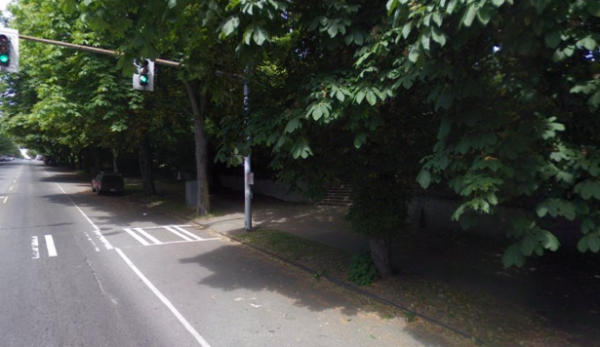This may seem obvious to anyone who has ever followed a diesel bus up a steep hill, but the air quality several feet away from motor vehicle lanes is significantly cleaner and healthier, according to a new study by PSU researchers.
Researchers set up P-trak instruments on the driver and passenger sides of a car parked between general traffic and the city’s new separated bike lane on SW Broadway to measure the number of particles in the air. The study concluded that there is a statistically significant difference in air quality on the separated bike lane side. From their conclusion (excerpted by Bike Portland):
The findings of this study show a cycle track roadway design may be more protective for cyclists than a traditional bicycle lane in terms of lowering exposure concentrations of ultrafine particles… Based on these initial findings, understanding roadway and traffic effects on exposure levels can help guide bicycle facility design and pinpoint locations in which mitigation of exposure levels by placement of facilities such as cycle tracks may be most important.”
— Advertisement —
This is yet another advantage to separated bike lanes that is often left out of discussions. Especially when climbing, air quality is important. There are few things less pleasant (and unhealthy) than taking a deep inhale of motor vehicle exhaust. The list of health advantages of riding a bike is long, but the extra exposure to exhaust is not one of them.
Back when we were debating the Dexter separated bike lane plans, most concerns centered around the potential dangers of riding quickly in a separated facility going downhill. Those concerns are still worth considering. However, one advantage of having a parking-separated lane on the uphill segments would have been decreased exposure to exhaust during the moments people are breathing the heaviest. Perhaps it’s not the most important safety detail, but it’s worth including in the equation when discussing different styles in the future.
When I used to live near 42nd and Fremont Ave, I would ride on the sidewalk near B.F. Day instead of the bike lane when going uphill on Fremont Ave:
 For one, it is a wide sidewalk, so my slow-going bike was not a problem for people walking. It is also prettier over there (and the trees provide cover from the rain). But most of all, the air is just so much better. Taking a deep breath feels and smells fresh. It’s a short, pleasant break from clouds of exhaust from the 5 or from an old, broken car working hard to make it up the hill.
For one, it is a wide sidewalk, so my slow-going bike was not a problem for people walking. It is also prettier over there (and the trees provide cover from the rain). But most of all, the air is just so much better. Taking a deep breath feels and smells fresh. It’s a short, pleasant break from clouds of exhaust from the 5 or from an old, broken car working hard to make it up the hill.








Comments
4 responses to “The air is better on the other side of the parked cars”
I think the poor visibility from right turning vehicles was still a major concern on uphill Dexter. Maybe even worse since bikers are going slower?
BUT, parking separated uphill bike lane on Fremont Ave? Genius! At least from 36th to 41st since that is the steepest part and there are is no right turning traffic for the entire stretch (except for the already unique intersection at 39th which surely could be accommodated safely). I can’t think of any reason why this couldn’t work. I love it.
Also brings to mind the studies on the low air quality inside autos, such as “In-Car Air Pollution: The Hidden Threat to Automobile Drivers”.
Other studies trying to figure out pollution risk to cyclists have used actual cyclists riding with masks that measured particulate inhalation; they found cyclists inhaled 4-5x more nanoparticles than car passengers on the same route. It would’ve been nice if the PSU study had used such a technique, instead of using stationary sensors which would seem to very poorly represent actual cyclist behavior. When traffic is very slow or stopped, I rarely stand still between the idled traffic and the parked cars just breathing exhaust; I move past the cars. If I find myself stuck behind a diesel belcher, I either fall back to give it some space (both so I can breathe and stay visible), or I pass it. On the other hand, as you point out, when going uphill you’re going to suck in more than if you’re just riding on level ground. Seems like these stationary sensors would’ve caught none of that variation.
This is a big why I try to avoid automotive arterials entirely, and the idea of establishing bicycle boulevards away from automotive arterials appeals to me more than putting bike facilities on automotive arterials. Alas, with the numerous choke points in the area, there are many places where separation isn’t quite as workable.
And just a note on the “smelly diesel bus” bit, many of the hazardous vehicle emissions are the colorless odorless things like carbon monoxide. The fact that exhaust from one vehicle smells and the exhaust from another doesn’t is no reason to feel better about the second. I consider diesel exhaust more “honest” because primary local health hazard of diesel exhaust, particulate matter, is fairly visible. Some prominent but invisible toxins in gas engine exhaust, carbon monoxide for example, are almost entirely absent from diesel engine exhaust.